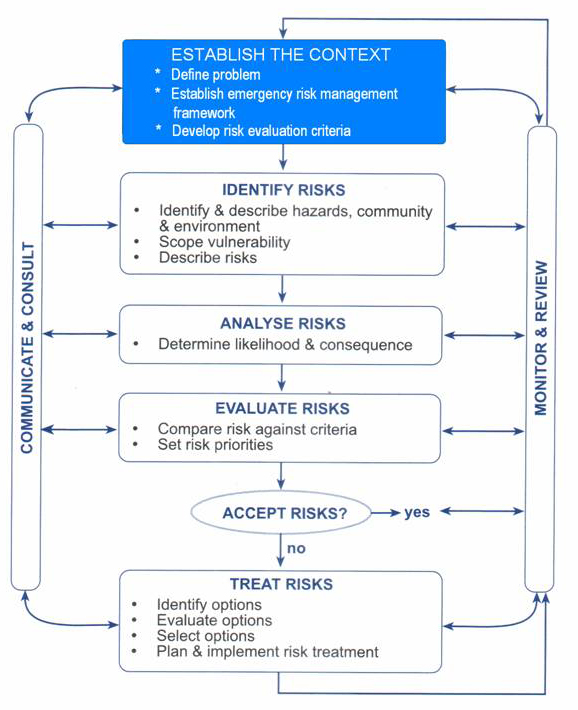Establishing the context
Establishing the context of a risk management programme or a risk assessment project provides is the first step in the risk assessment process
It provides a "game plan" or set of rules against which the project or programme is conducted. Establishing the context at the very start of your risk assessment project enables you to identify and set the scope, limitations, boundaries, policies, practices, relationships, internal and external influences that will determine how your project is conducted.
Figure 3.1
Emergency Risk Management Process
Source: Emergency Management Australia, 2000, Emergency risk management applications guide, EMA: Canberra.
Activity 3.1
|
Read
Textbooks: Standards Australia / Standards New Zealand (2004), AS/NZS 4360/2004 Risk management. Sydney . - pp 12 - 15, Section 3.2 Establish the Context.
Emergency Management Australia, (2000), Emergency risk management: Applications guide. EMA: Canberra - pages 8 - 10 Establish the context. |
The Standards Australia/ Standards New Zealand reading provides a generic explanation of what establishing the context entails. The Emergency Risk Management Applications Guide reading provides a more specific focus on establishing the context from an emergency risk management stance. As you read through each section of the readings, take some time to start jotting down those contextual aspects of your proposed risk assessment project. This information will be extremely useful in the following sections as you start to define your risk assessment project in more detail.
Questions that you should be answering are:
- What is the problem? ie. What is the nature and scope of issues that you will need to address to improve your selected community's safety? Remember here we are defining boundaries within which the framework for the project can be established, not identifying solutions!
- How will emergency risk management be applied to solve your problem? Here you should consider the following:
- Who are the stakeholders?
- What is the applicable legislation and/ or policies?
- What are the applicable management arrangements?
- Are there any political or economic circumstances that will influence the project?
- Are there any social or cultural issues that will influence the project?
- Are there any organizational, operational or industry specific issues that will influence the project?
- Finally, what are the criteria against which you will evaluate your risks?
Print this activity
|

